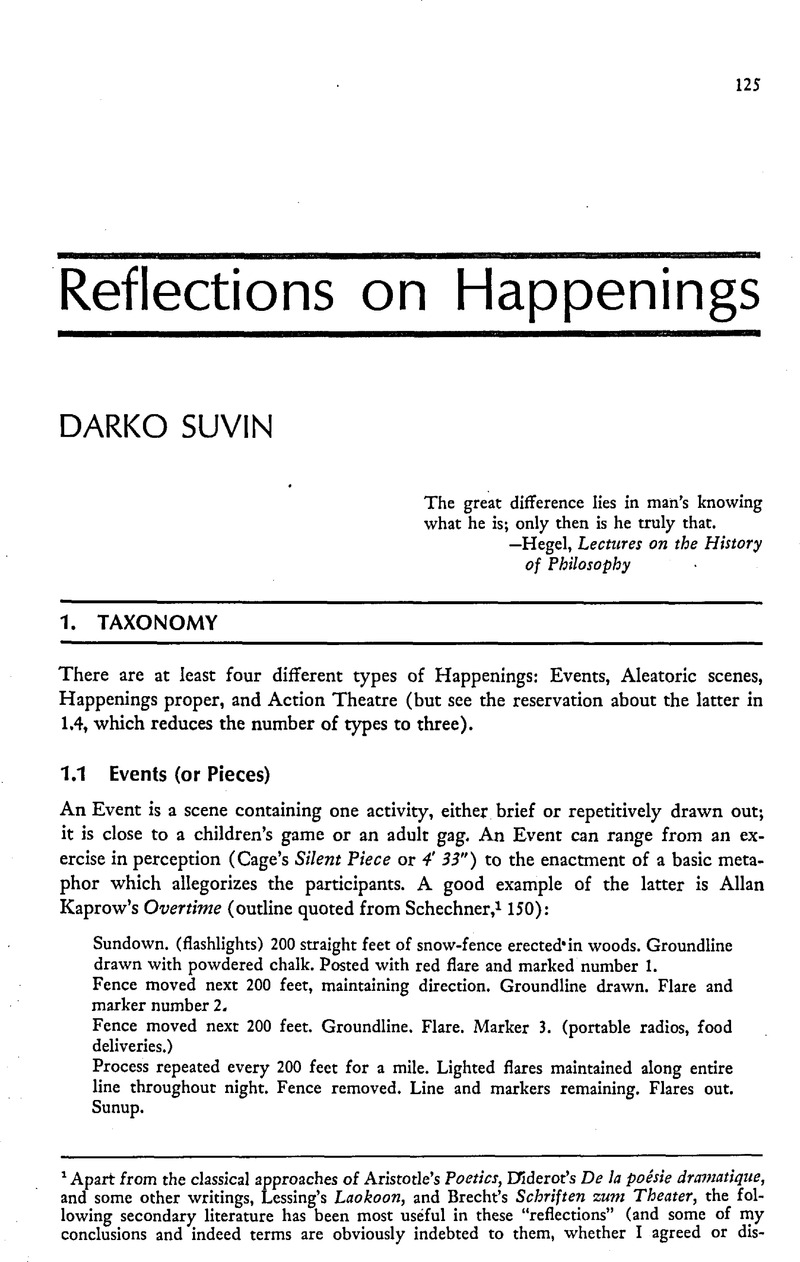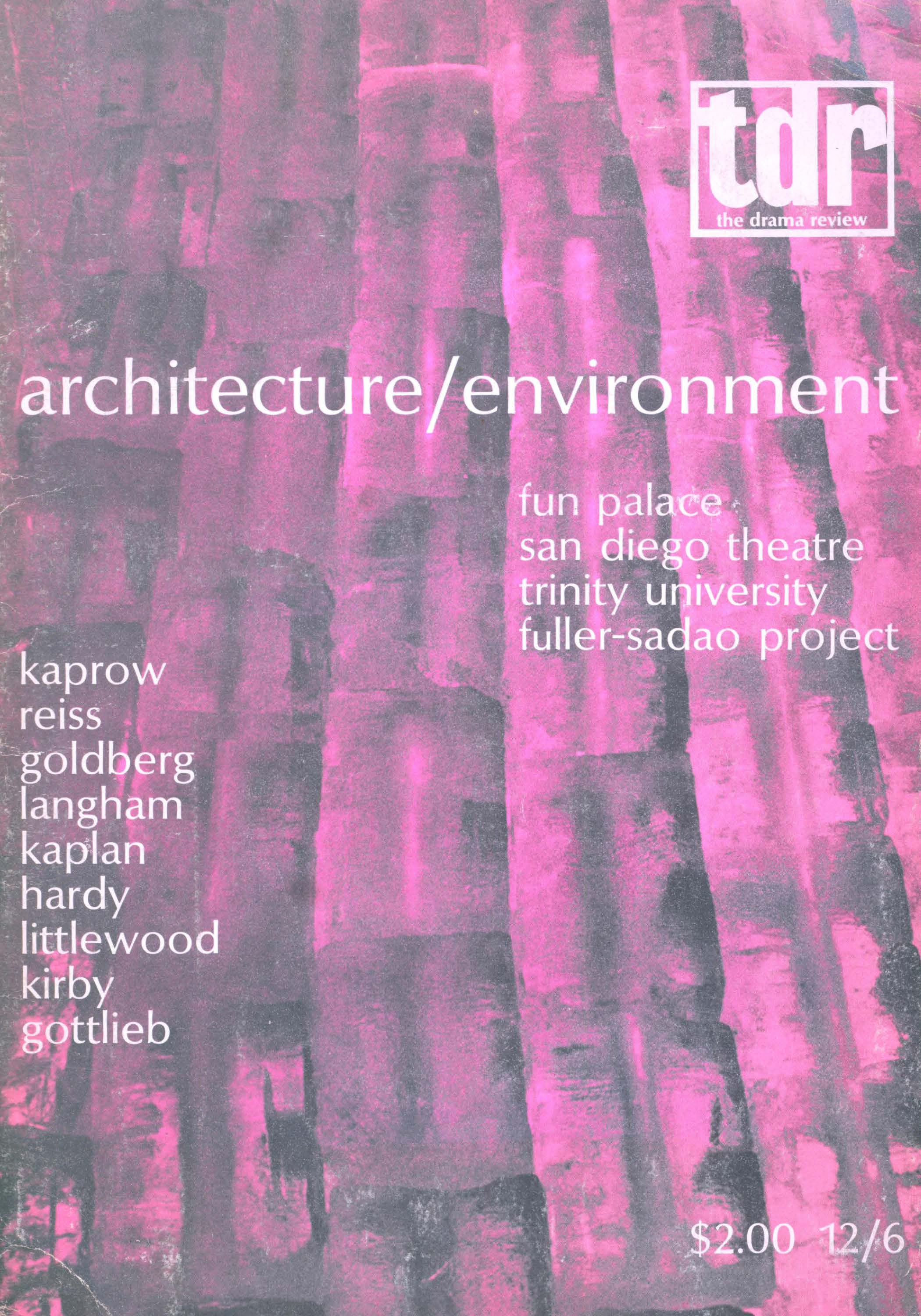Article contents
Reflections on Happenings
Published online by Cambridge University Press: 07 December 2021
Abstract

- Type
- Other
- Information
- Copyright
- Copyright © 1970 The Drama Review
References
1 Apart from the classical approaches of Aristotle's Poetics, Diderot's De la poésie dramatique, ‘ and some other writings, Lessing's Laokoon, and Brecht's Schriften zum Theater, the following secondary literature has been most useful in these “reflections” (and some of my conclusions and indeed terms are obviously indebted to them, whether I agreed or disagreed with them). When quoted, they will be indicated in parentheses by author's name with the pages following in Arabic numerals; otherwise they will as a rule not be acknowledged in the course of the essay:
Baxandall, Lee. “Beyond Brecht: the Happenings.” Studies on the Left, January-February, 1966.
Eco, Umberto. Opera aperta. Milan: 1967.
Higgins, Dick. FOEW & OMBWHNW. New York-Barton-Cologne: 1969.
Kaplan, Donald M. “Character and Theatre.” TDR 32(1966) :93-108.
Kaprow, Allan. Some Recent Happenings. New York: 1966.
Kaprow, Allan. Untitled Essay and other works. New York: 1967.
Kirby, Michael, ed. Happenings. New York: 1965. With statements and scripts by Allan Kaprow, Claes Oldenburg, Robert Whitman, and others.
Lebel, Jean-Jacques. Le happening. Paris: 1967.
Manifestos. New York: 1966. By Ay-o and others.
Schechner, Richard. Public Domain. New York: 1969.
Sontag, Susan. Against Interpretation. New York: 1969.
Tarrab, Gilbert. “Le happening.” Revue d'histoire du théâtre.Special issue, 1968.
TDR 30 (1965). Issue devoted to Happenings.
Let me also make it clear that, though I have seen some performances billed as Happenings in Europe and America, I have worked basically from scenarios and descriptions, just as if discussing the commedia dell'arte, since my chief interest is in this case not that of a chronicler but that of a “socio-formalist” theoretician of spectacle.
2 See an account of it in Kirby, TDR 30, pp. 34-36, and of its direction by Judith Malina in Biner, Pierre, Le Living Theatre (Lausanne: 1964), pp. 52-53.Google Scholar
3 Cp. Schechner on Ann Halprin's dance-Happening Esposizione: “the similarity of one human being to another and the ineluctable unity which comes from a group doing roughly the same thing together” (Schechner, 149). Kaprow himself lucidly notes that his symbols “are so general and so archetypical that actually almost everyone knows vaguely about these things,” since he tries to keep them “universal, simple, and basic” (Kirby, ed., Happenings, 50)
4 Oldenburg himself mentions that in Fotodeath “ events repeated themselves in superimposed lines of movement,” which seems a brief painterly way of saying much the same thing I was trying to get at above.
5 The main works dealing with this theory are:
Shklovsky, Viktor. Rozanov.Petrograd: 1921.
Shklovsky, Viktor. Khod konya. Berlin: 1923.
Shklovsky, Viktor. Literatura i-kinematograf. Berlin: 1923.
Tinyanov, Yury. Arkhaisty i novatory.Leningrad: 1929.
Tomashevsky, Boris. Teoriya Hteratury. Poetika.Moscow-Leningrad: 1925.
Most quotations have been taken from the excellent study by Professor Victor Erlich, Russian Formalism (The Hague: 1955); see also René Wellek and Austin Warren, Theory of Literature (New York: 1956), chapter 17. Another English-language book, Russian Formalist Criticism: Four Essays,translated and edited by Lee T. Lemon and Marion J. Reis (Lincoln, Nebraska: 1965), has gaps and terminological difficulties.
6 Whitman was quoted to that effect in Happenings, 180.
7 Michael Kirby developed the hypothesis of Happenings being defined by a performance nonmatrixed by time, place, or character in the introduction to his anthology Happenings (see note 1); Donald M. Kaplan was referring to the restatement in Kirby's article “The New Theatre” in the TDR special issue on Happenings which Kirby co-edited. I would like to stress that though I disagree with Kirby in some jpasic aspects, I found his notion and term of matrixing a really useful contribution to a not merely impressionistic discussion of the genre.
8 Etienne Souriau, Les grands problèmes de l’esthéâtique theatrale (Paris: 1962), p. 11.
Souriau has enlarged on this score in several other works, e.g., in his presentation of the anthology L'Univers filmique, and in the well-known Les Deux cent miille situations dramatiques, both Paris, n.d.
9 For a reading of mimesis as (re)presentation or performing preferably to copying or simple imitating, see my brief argumentation in “The Mirror and the Dynamo,” TDR 38 (1967),pp.58-59.
10 An excellent formulation of that process can be found in Kaprow, Allan, Assemblages, Environments,and Happenings (New York: 1967), pp. 165-166.Google Scholar
11 This section of the essay uses, besides Masque texts and the accounts of E. K. Chambers, The Elizabethan Stage I-IV (Oxford: 1923), insights from:
Cunliffe, John W. “Italian Prototype of the Masque and Dumb Show.” PMLA XXII (1907).
Evans, Herbert Arthur. English Masques. London: 1897.
Frye, Northrop. Anatomy of Criticism. New York: 1966.
Furniss, W. Todd. “Ben Jonson's Masques.” In Three Studies in the Renaissance. New Haven: 1958.
Gilbert, Allan H. The Symbolic Persons in the Masques of Ben Jonson.Durham, N.C.: 1948.
Honig, Edwin. Dark Conceit. New York: 1966.
Nicolson, Marjorie Hope. The Breaking of the Circle. New York: 1960.
Orgel, Stephen. The Jonsonian Masque.Cambridge, Mass.: 1965.
Prunières, Henri, Le ballet de cour en France avant Benserade et Lully.Paris, n.d.Reyher, Paul. Les masques anglais. Paris: 1909.
Rossiter, A. P. English Drama from Early Times to the Elizabethans. London: 1950.
Schoenbaum, Samuel, ed. Essays Principally on Masques and Entertainments.Chicago: 1968.
Talbert, Ernst W. “The Interpretation of Jonson's Courtly Spectacles.” PMLA LXI (1946).
Taylor, R. A. Aspects of the Italian Renaissance.London: 1923.
Welsford, Enid. The Court Masque. Cambridge: 1927.
These books will be quoted by author's name and page in parenthesis. See also R. B. Parker's parallel of “Dramaturgy in Shakespeare and Brecht,” University of Toronto Quarterly, No. 3, 1963.
12 Block, Haskell, Mallarmé and the Symbolist Drama (Detroit: 1963), p. 86.Google Scholar I already mentioned affinities with expressionist, surrealist, and futurist drama, and Kirby has gone much further in following one tradition behind the'Happenings (the so-called dadaist one) in the introduction to Happenings.
13 See the essay in note 8. This part of the essay owes much to Lee Baxandall's article (see note 1); though I am dubious about his basic stance, he had the perspicacity of first posing and problematizing the crucial comparison of the two estrangements—Brecht's and the Happenings'. It also owes much to discussions with Richard Schechner, before and after his quoted book.
14 Al Hansen, A Primer of Happenings & Time/Space Art (New York-Paris-Cologne: 1965), p. 34.
15 See on the other hand Oldenburg's remarks on his Gayety, a very interesting manifestation of the tension which went into the making of that “civic spectacle”: “In Gayet I want to create Chicago, in the way I see it…. I think of O'Henry's or anyone else's municipal report, sociological studies, etc., but that mine is poetic/satiric/symbolic. The enigmatic portions may be taken to be the situation of the spirit in the community, often these have a violent turn. The relation of the incidents js fortuitous as is the case in real life…. Unfortunately I am limited to typicalities, but the spectator may imagine the numbers. The piece closes with a Finale, an apotheosis, in the form of a destruction which always seems appropriate in which the forces of the community are released functionlessly in relieving chaos” (Happenings, 234-235).
16 See Georg Lukács, Geschichte und Klassenbewusstsein(Neuwied: 1969), and Maurice Merleau-Ponty, Signes(Paris: 1960), passim.
17 I am indebted for this observation, as well as for stimulating my interest in a possible parallel between Masque and Happening, to Professor Donald F. Theall of McGill University, and to his unpublished manuscript of an address to McGill alumni from fall 1968 which he kindly allowed me to refer to.
18 Lukács, Georg, “Gedanken zu einer Aesthetik des Kinos,” in Schriften zur Literatursoziologie (Neuwied, 1968), p. 78.Google Scholar
- 3
- Cited by


